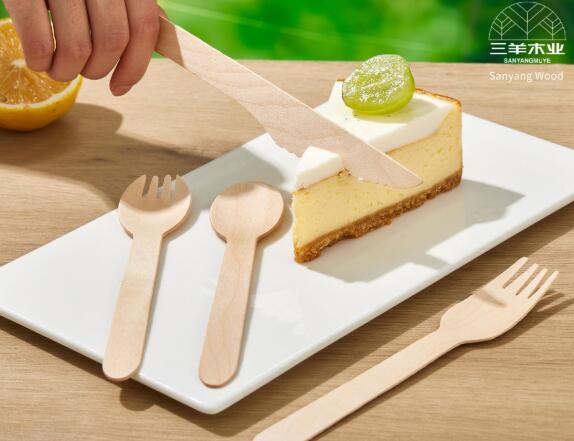

As the world grows more aware of the environmental threats posed by plastic pollution, businesses and individuals alike are embracing eco-friendly alternatives to everyday items—such as disposable cutlery. Single-use utensils are a staple of food services, events, and even takeaways, but they also contribute significantly to global waste. So, the question arises: What is the best disposable cutlery for the environment?
From disposable wooden cutlery to bamboo utensils and compostable plastics, there’s no shortage of sustainable options on the market. However, not all of them are equally eco-friendly or practical. In this blog, let’s evaluate the top contenders to discover which is the most sustainable and functional choice for lowering your environmental impact.
Single-use plastic cutlery, once ubiquitous in fast food, takeout, and catering services, is now widely recognized as a major contributor to global pollution. Lightweight plastic utensils are often non-biodegradable and difficult to recycle, resulting in significant harm to ecosystems, especially when they end up in oceans or landfills.
The good news is that a wide range of eco-friendly alternatives is available today, from disposable wooden cutlery to compostable plastics. Choosing the right cutlery goes beyond making environmentally conscious decisions. Businesses that adopt sustainable options are also meeting consumer demand for greener products while adhering to regulatory restrictions banning single-use plastics in many countries.
But which option is the best choice for sustainability, practicality, and cost-effectiveness? Let’s dive into the options.

When it comes to sustainable disposable cutlery, there are several options worth considering. Here’s a breakdown of the most common choices.
Disposable wooden cutlery has become one of the most popular alternatives to plastic cutlery, and for good reasons:
Eco-Friendly and Biodegradable: Made from natural materials like birchwood, it breaks down quickly in the environment.
Renewable Source: Many factories produce these utensils using sustainably harvested wood, ensuring minimal environmental harm.
Aesthetic Appeal: Wooden cutlery has a rustic and natural look that lends a premium feel to food service offerings.
Moreover, disposable wooden cutlery factories increasingly adopt sustainable practices, including replanting trees and using eco-friendly production methods. This makes wooden cutlery a top contender for sustainability-conscious businesses.
Bamboo is another eco-friendly material surging in popularity.
Fast-Growing and Renewable: Bamboo grows incredibly quickly (as much as three feet daily!), making it one of the most sustainable resources available.
Durable and Attractive: Bamboo cutlery is stronger than standard wooden cutlery, with a sleek and modern design.
Biodegradable: Like wooden cutlery, bamboo breaks down naturally in the environment.
However, bamboo products are generally more expensive than wooden or compostable plastic alternatives, which might not be ideal for businesses with smaller budgets.
Compostable plastics, made from plant-based materials like corn starch or sugarcane, mimic the look and feel of traditional plastic without the detrimental environmental effects.
Pros:
Biodegradable under industrial composting conditions.
Similar texture and look to regular plastic, making it familiar for consumers.
Cons:
Requires industrial composting facilities to break down properly, which may not be accessible in all regions.
Can still leave residues if not disposed of correctly.
While compostable plastics bridge the gap between sustainability and practicality, they don’t offer the same natural appeal as disposable wooden cutlery.
For those looking for innovation, edible cutlery could be the way forward. Made from materials like wheat or rice, edible spoons, forks, and knives can be eaten after use.
Novelty Factor: Offers a unique experience for consumers, especially at high-end events or eco-focused campaigns.
Eco-Friendly: Eliminates waste entirely.
Challenges: High cost, limited availability, and reduced durability make it impractical for widespread use.
Each type of eco-friendly disposable cutlery has its merits, but disposable wooden cutlery excels in several key areas:
Wooden cutlery is 100% biodegradable and compostable, making it an ideal choice for businesses and individuals aiming to reduce waste. Because it requires minimal industrial processing to decompose, it causes far less environmental harm than compostable plastics that rely on special facilities.
Wood, especially birchwood, is a renewable resource when sourced responsibly. Many disposable wooden cutlery factories are committed to sustainable forestry practices, such as replanting trees to offset their resource use. This makes wooden cutlery a greener option compared to materials that rely on high input costs or intensive farming, like bamboo.
Wooden cutlery is lightweight, sturdy, and versatile enough for all types of foods, from entrees to desserts. Its rustic yet elegant look is appealing for businesses, whether you’re running a cozy café, catering a wedding, or packaging eco-friendly takeout orders.
While slightly more expensive than single-use plastics, wooden cutlery is more affordable than bamboo and scales well for businesses when ordered in bulk through a disposable wooden cutlery factory.
Although disposable wooden cutlery has notable advantages, it’s not entirely without limitations:
Taste and Texture: Some users report a slight wooden aftertaste or find its texture less smooth compared to plastic.
Higher Costs Relative to Plastic: Wooden cutlery costs more than traditional plastic utensils, especially for smaller businesses.
Splintering Risks: Low-quality wooden cutlery may splinter, though this can be avoided by working with trusted suppliers.
If wooden cutlery seems like the best fit for your needs, here are some key tips to maximize its benefits:
Source From Reputable Manufacturers: Partner with a disposable wooden cutlery factory that follows sustainable practices and guarantees premium-quality products.
Buy in Bulk: This reduces costs for businesses while ensuring you always have enough utensils on hand.
Evaluate Certification Requirements: Check for certifications like FSC (Forest Stewardship Council) or PEFC (Programme for the Endorsement of Forest Certification) to ensure sustainable sourcing.
After evaluating the leading options, disposable wooden cutlery emerges as the best overall choice for the environment. Its combination of biodegradability, sustainable sourcing, and practicality makes it suitable for both casual and professional use. While bamboo and compostable plastics have their merits, wooden cutlery strikes the ideal balance of cost, availability, and eco-friendliness.